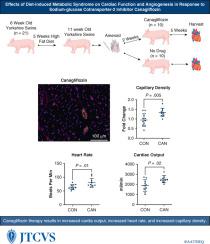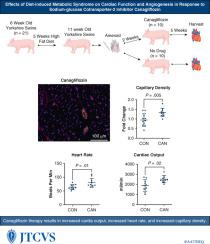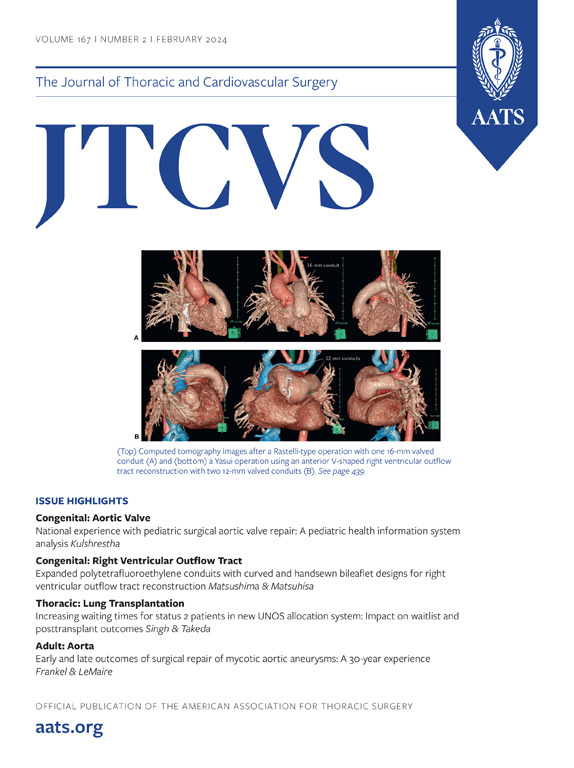饮食引起的代谢综合征对钠-葡萄糖转运体-2抑制剂卡那格列净的心功能和血管生成的影响
IF 4.9
1区 医学
Q1 CARDIAC & CARDIOVASCULAR SYSTEMS
Journal of Thoracic and Cardiovascular Surgery
Pub Date : 2024-11-01
DOI:10.1016/j.jtcvs.2024.06.004
引用次数: 0
摘要
简介:钠-葡萄糖共转运体-2(SGLT-2)抑制剂是一种抗糖尿病药物,在临床研究中已被证明可减少心血管事件和心衰相关死亡率。我们试图在与临床相关的慢性心肌缺血(CMI)模型中研究代谢综合征(MS)与 SGLT-2 抑制剂卡格列净(CAN)之间复杂的相互作用:21头约克夏猪从6周龄开始喂食高脂肪饮食以诱发MS。11 周时,所有约克夏猪都在左侧冠状动脉周围放置了一个气囊收缩器,以诱导慢性心肌缺血。两周后,猪只接受对照组(CON,n=11)或 CAN 300 毫克每日 PO(n=10)治疗 5 周,然后所有猪只接受末期收割:结果:与对照组相比,CAN 组的心输出量和心率明显增加,脉压下降(均为 p):在多发性硬化症的猪 CMI 模型中,CAN 治疗可显著增加毛细血管密度并增强心脏功能。这项研究进一步阐明了 SGLT-2 抑制剂在心脏病患者中的作用机制;不过,还需要更多的研究来确定毛细血管密度的增加是否在临床研究中起到了改善作用。本文章由计算机程序翻译,如有差异,请以英文原文为准。


Effects of diet-induced metabolic syndrome on cardiac function and angiogenesis in response to the sodium-glucose cotransporter-2 inhibitor canagliflozin
Introduction
Sodium-glucose cotransporter-2 inhibitors are antidiabetic medications that have been shown to decrease cardiovascular events and heart failure-related mortality in clinical studies. We attempt to examine the complex interplay between metabolic syndrome and the sodium-glucose cotransporter-2 inhibitor canagliflozin (CAN) in a clinically relevant model of chronic myocardial ischemia.
Methods
Twenty-one Yorkshire swine were fed a high-fat diet starting at 6 weeks of age to induce metabolic syndrome. At 11 weeks, all underwent placement of an ameroid constrictor around the left circumflex coronary artery to induce chronic myocardial ischemia. After 2 weeks, swine received either control (CON) (n = 11) or CAN 300 mg by mouth daily (n = 10) for 5 weeks, whereupon all underwent terminal harvest.
Results
There was a significant increase in cardiac output and heart rate with a decrease in pulse pressure in the CAN group compared with CON (all P values < .05). The CAN group had a significant increase in capillary density (P = .02). There was no change in myocardial perfusion or arteriolar density. CAN induced a significant increase in markers of angiogenesis, including Phospho-endothelial nitric oxide synthase, Endothelial nitric oxide synthase, vascular endothelial growth factor receptor-1, heat shock protein 70, and extracellular signal-regulated kinases (all P values < .05), plausibly resulting in capillary angiogenesis.
Conclusions
CAN treatment leads to a significant increase in capillary density and augmented cardiac function in a swine model of chronic myocardial ischemia in the setting of metabolic syndrome. This work further elucidates the mechanism of sodium-glucose cotransporter-2 inhibitors in patients with cardiac disease; however, more studies are needed to determine if this increase in capillary density plays a role in the improvements seen in clinical studies.
求助全文
通过发布文献求助,成功后即可免费获取论文全文。
去求助
来源期刊
CiteScore
11.20
自引率
10.00%
发文量
1079
审稿时长
68 days
期刊介绍:
The Journal of Thoracic and Cardiovascular Surgery presents original, peer-reviewed articles on diseases of the heart, great vessels, lungs and thorax with emphasis on surgical interventions. An official publication of The American Association for Thoracic Surgery and The Western Thoracic Surgical Association, the Journal focuses on techniques and developments in acquired cardiac surgery, congenital cardiac repair, thoracic procedures, heart and lung transplantation, mechanical circulatory support and other procedures.

 求助内容:
求助内容: 应助结果提醒方式:
应助结果提醒方式:


